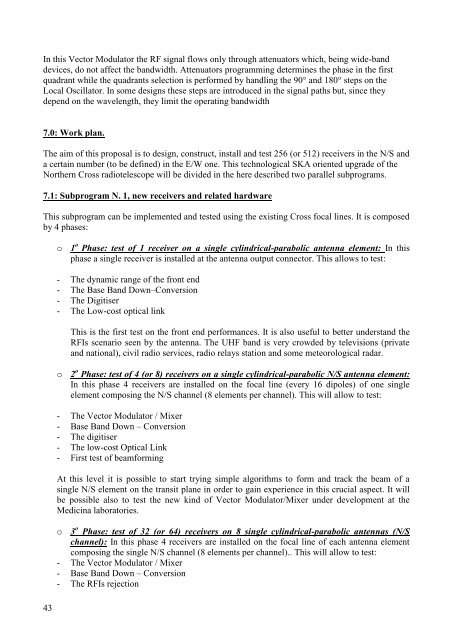The Medicina IRA-SKA Engineering Group
The Medicina IRA-SKA Engineering Group
The Medicina IRA-SKA Engineering Group
You also want an ePaper? Increase the reach of your titles
YUMPU automatically turns print PDFs into web optimized ePapers that Google loves.
In this Vector Modulator the RF signal flows only through attenuators which, being wide-band<br />
devices, do not affect the bandwidth. Attenuators programming determines the phase in the first<br />
quadrant while the quadrants selection is performed by handling the 90° and 180° steps on the<br />
Local Oscillator. In some designs these steps are introduced in the signal paths but, since they<br />
depend on the wavelength, they limit the operating bandwidth<br />
7.0: Work plan.<br />
<strong>The</strong> aim of this proposal is to design, construct, install and test 256 (or 512) receivers in the N/S and<br />
a certain number (to be defined) in the E/W one. This technological <strong>SKA</strong> oriented upgrade of the<br />
Northern Cross radiotelescope will be divided in the here described two parallel subprograms.<br />
7.1: Subprogram N. 1, new receivers and related hardware<br />
This subprogram can be implemented and tested using the existing Cross focal lines. It is composed<br />
by 4 phases:<br />
43<br />
o 1 o Phase: test of 1 receiver on a single cylindrical-parabolic antenna element: In this<br />
phase a single receiver is installed at the antenna output connector. This allows to test:<br />
- <strong>The</strong> dynamic range of the front end<br />
- <strong>The</strong> Base Band Down–Conversion<br />
- <strong>The</strong> Digitiser<br />
- <strong>The</strong> Low-cost optical link<br />
This is the first test on the front end performances. It is also useful to better understand the<br />
RFIs scenario seen by the antenna. <strong>The</strong> UHF band is very crowded by televisions (private<br />
and national), civil radio services, radio relays station and some meteorological radar.<br />
o 2 o Phase: test of 4 (or 8) receivers on a single cylindrical-parabolic N/S antenna element:<br />
In this phase 4 receivers are installed on the focal line (every 16 dipoles) of one single<br />
element composing the N/S channel (8 elements per channel). This will allow to test:<br />
- <strong>The</strong> Vector Modulator / Mixer<br />
- Base Band Down – Conversion<br />
- <strong>The</strong> digitiser<br />
- <strong>The</strong> low-cost Optical Link<br />
- First test of beamforming<br />
At this level it is possible to start trying simple algorithms to form and track the beam of a<br />
single N/S element on the transit plane in order to gain experience in this crucial aspect. It will<br />
be possible also to test the new kind of Vector Modulator/Mixer under development at the<br />
<strong>Medicina</strong> laboratories.<br />
o 3 o Phase: test of 32 (or 64) receivers on 8 single cylindrical-parabolic antennas (N/S<br />
channel): In this phase 4 receivers are installed on the focal line of each antenna element<br />
composing the single N/S channel (8 elements per channel).. This will allow to test:<br />
- <strong>The</strong> Vector Modulator / Mixer<br />
- Base Band Down – Conversion<br />
- <strong>The</strong> RFIs rejection
















